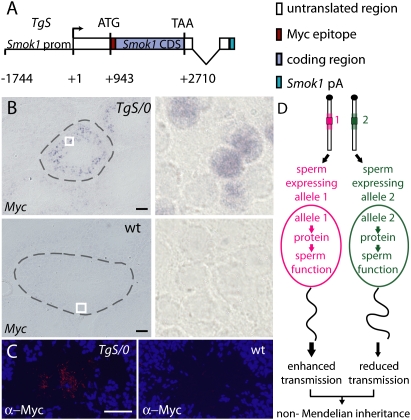Figure 4.
Smok1 shows the same pattern of transcriptional expression and post-transciptional control as Tcr. (A) Schematic drawing of the transgene construct TgS, consisting of the Smok1 promoter (Smok1 prom), the Myc epitope-tagged Smok1 coding region (Smok1 CDS), and untranslated regions followed by the polyadenylation signal (Smok1pA). (B) Testis cryosections of TgS/0 (top panel) or wild-type control (bottom panel) males hybridized in situ with a DIG-labeled Myc epitope-specific probe (Myc) show TgS expression in seminiferous tubules of the TgS/0 male in a subpopulation of round spermatids, but not in the control. White boxes indicate the regions shown at higher magnification on the right, and the borders of seminiferous tubules are indicated by dashed lines. Bar, 100 μm. (C) Immunofluorescent detection of Myc-Smok1 protein on cryosections of seminiferous tubules derived from a TgS/0 (left panel) or a wild-type control (right panel) male using anti-Myc antibodies visualizing Myc-Smok1 protein (red) specifically in the lumen filled with flagella of late-stage spermatids. Nuclei are visualized by DAPI staining (blue). Bar, 50 μm. (D) Model depicting a mechanism leading to non-Mendelian inheritance of functionally different alleles (denoted 1 and 2), as well as genetically linked chromosomal regions (shaded area), of a gene involved in sperm function due to post-meiotic expression and retention of the gene products in the haploid spermatids, thus creating functionally different spermatozoa.

